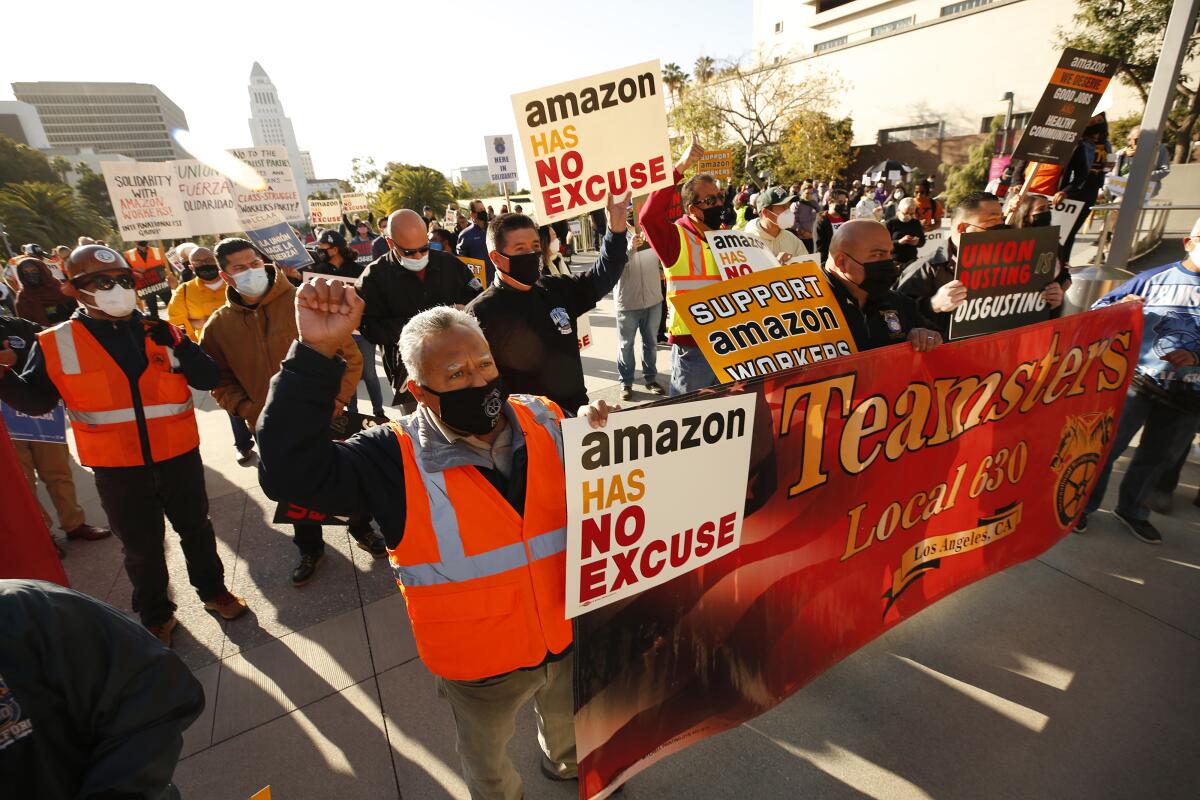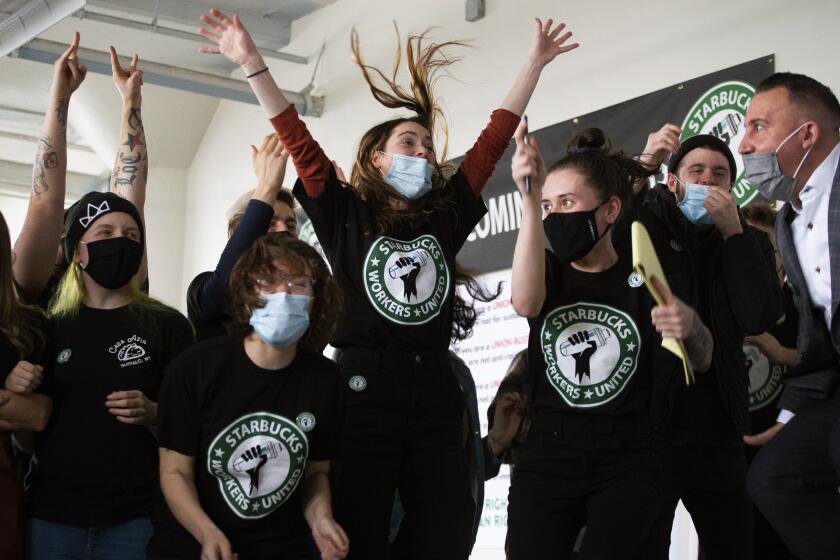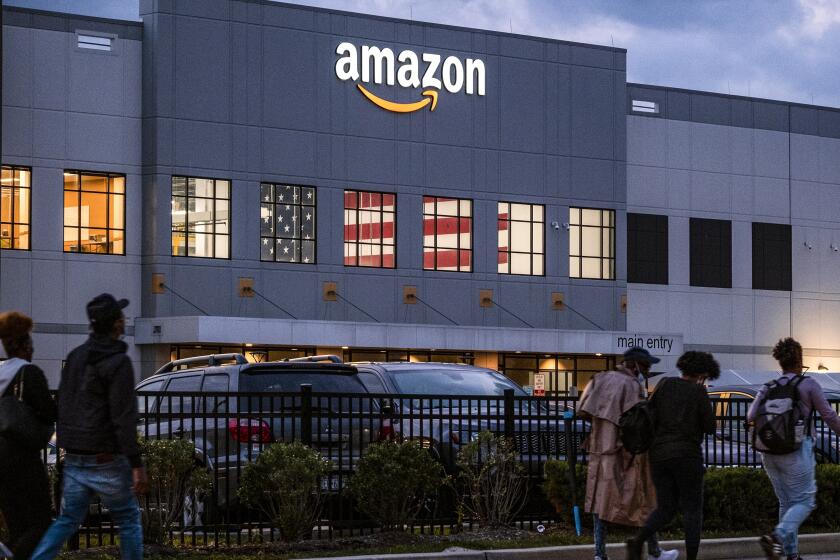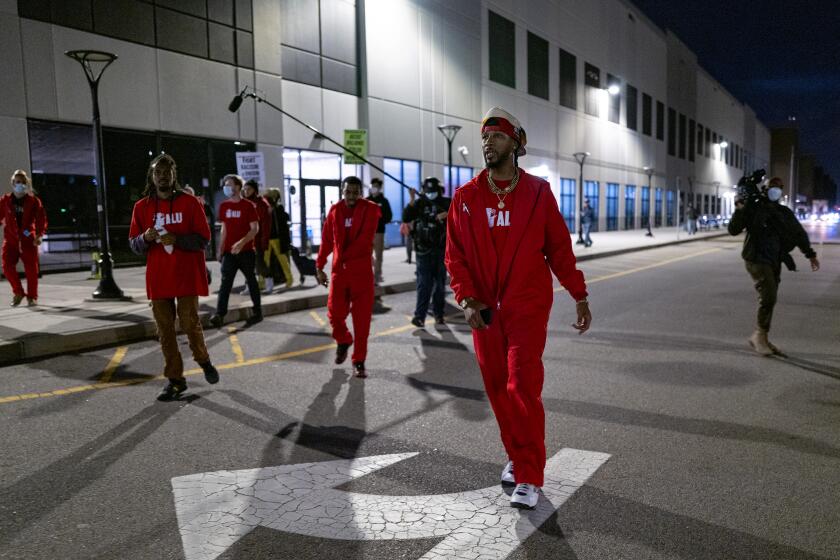Opinion: Think getting a raise from the boss is hard? Try asking for this

- Share via
Like many front-line workers across the country, Denise Kohr saw her pay at Amazon increase over the past year; as for her say, not so much.
“They don’t want to hear from me,” complained Kohr, who has picked and packed products at a fulfillment center in Carlisle, Pa., since 2018.
Kohr — who after a 25-cent bump last fall, along with a shift change that boosted her wage, now makes $22.95 an hour — wishes she earned more money. But her bigger frustration is this: Whenever she makes a suggestion about how work should get done, she is invariably dismissed by management. “It can’t possibly be a good idea,” she said, if it’s coming from an entry-level employee.
A tight job market and smart public policy have translated into wage gains for many lower-income workers. Though it’s unclear how long the trend will last, and there is still a long way to go for tens of millions to reach a true living wage, those at the lower end of the pay distribution have made up a ton of ground since the COVID-19 pandemic.
But while the pay gap has narrowed, what scholars call the “voice gap” doesn’t seem to have budged.
With wins at Starbucks, Amazon, Trader Joe’s and Apple, we haven’t seen this kind of momentum since the 1930s.
New research reveals that a majority of workers, young and old, don’t believe they have the right amount of say when it comes to compensation and paths to promotion. A sizable gap also exists on issues such as training and scheduling. Meanwhile, Gallup polling shows that only 30% of U.S. employees feel their opinions at work count.
This lack of voice comes against the backdrop of a “hot labor summer,” with Southern California hotel workers, as well as Hollywood writers and actors, going on strike, and UPS drivers threatening to do so before the Teamsters union was able to win what it termed a “historic” contract in July. The United Auto Workers, whose contract is up in September, are the latest to consider taking to the picket lines.
At least some of the agitation can be interpreted as a blowback to constant stifling by corporate America. “All we want is ... to have a little more dignity, and to have more of a say in what we have to do on a day-to-day basis,” Jaysin Saxton, a worker and union organizer at a Starbucks in Augusta, Ga., told a Senate committee in March.
Perhaps the most curious thing about companies not listening more to their workers is that it’s bad for business. Gallup estimates that if 6 in 10 employees had faith that their opinions matter, rather than just 3 in 10, organizations could realize a 27% reduction in turnover, a 40% drop in safety-related incidents, and a 12% uptick in productivity. When workers use their voice, it can also spur innovation — an indication that many employees are eager to contribute, not just carp.
It takes two years on average to recover from the trauma of job loss. The social costs of mass layoffs are enormous. Other nations have ways to avoid this.
So why, then, don’t more companies seek employee input?
For one thing, executives tend to be confident they have a pulse on their employees’ thinking, thanks to HR surveys, on-site visits and “open-door” policies that, at least in theory, allow workers to contact upper management without fear of retaliation. The problem is that these mechanisms are prescribed by the company itself. “Those are not substitutes for real worker voice,” said Tom Kochan, a professor at the MIT Sloan School of Management.
Indeed, some executives find giving workers more real say even tougher to do than raising pay because that requires sharing something more precious than money: a bit of their power. In addition, managers worry that allowing workers more voice might lead to unionization — something most employers are determined to defy at all costs.
Still, the fear of collective bargaining explains only part of management’s unwillingness to heed workers’ recommendations. “It’s deeper than that,” said Bianca Agustin, co-executive director of United for Respect, a workers’ rights organization. “It’s just a disrespect for working people and what management thinks they can bring to the table.”
The legal delay likely to come will give a bird’s-eye view of why unions represent just 6% of the private sector workforce.
As an example, Agustin pointed to a shareholder resolution at Walmart submitted by an hourly worker and United for Respect member named Cynthia Murray. Her proposal sought an independent review of company policies and practices on workplace safety and violence, including gun violence. “As a 22-year Walmart associate,” Murray declared, “I am personally invested in keeping myself and my fellow associates safe at work.”
At Walmart’s annual meeting in May, Murray’s resolution received nearly 24% of the vote — well above the 20% threshold that proxy advisory firm Glass Lewis says should lead the board of directors to “engage with shareholders ... and demonstrate some initial level of responsiveness.” Yet Walmart won’t meet with Murray, telling her in a letter that it already regularly reviews its protocols to “ensure a safe and healthy work environment.”
“If she were any other shareholder — not a worker — the vote would have triggered a dialogue,” Agustin said. “It’s very discouraging.”
All sorts of notions have been put forth to bolster workers’ voice: placing rank-and-file employees on corporate boards, creating European-style works councils, expanding employee ownership and more.
But the most straightforward approach is to make it easier for workers to unionize — something that has proved a very tall order despite a surge in organizing efforts over the last few years and soaring popularity for unions. In 2022, a mere 10.1% of American workers were unionized, the lowest rate on record.
As the hot labor summer fades to fall, it’s hard to be sure what will become of the high-profile union drives underway. Even where labor organizers make inroads, like at Starbucks, companies can take advantage of toothless labor laws and delay negotiating, in hopes that worker excitement for a union will wither away.
An economic justice agenda and standing firm against two-tier pay systems are helping unions gain public respect.
Not only would that mark another setback for workers seeking more control over employment conditions, but it would imperil a chance to elevate the voice of the worker in national affairs.
A rich body of scholarship has established a clear connection between union strength on the one hand and political stability and economic and social justice on the other. With unions diminished, “you create the room for demagogues to grow,” said Ray Marshall, who served as Labor secretary under President Carter.
By contrast, when unions had a more robust presence in the United States, representing a third or so of all workers in the 1950s and ’60s, organized labor played a key role in civil rights and other movements pushing for equality.
Unions are mechanisms for building civic bonds and engagement. “People want to know how to get involved,” said John Ahlquist, a professor at UC San Diego’s School of Global Policy and Strategy. “You get a very different answer if it’s coming from the Proud Boys than if it’s coming from a union.”
When employees’ voices are ignored or squelched, it is terrible for workplace democracy. It may be even worse for American democracy.
Rick Wartzman is the co-president of Bendable Labs, a technology, consulting and research firm. His most recent book is “Still Broke: Walmart’s Remarkable Transformation and the Limits of Socially Conscious Capitalism.” This article was produced in partnership with Zócalo Public Square.
More to Read
A cure for the common opinion
Get thought-provoking perspectives with our weekly newsletter.
You may occasionally receive promotional content from the Los Angeles Times.














